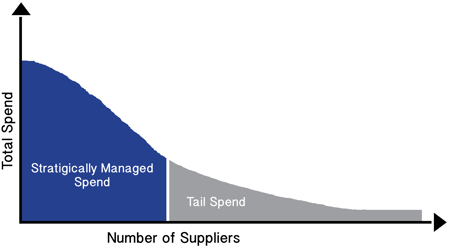Addressing “tail spend” is not something on many procurement teams' minds It is generally not given much attention, but may be the largest segment of your spend and the largest untapped source of savings.
Tail spend defined
Tail spend, in its simplest form, is the 20 percent of an organization’s spend that is derived from 80 percent of their suppliers. 
Tail spend can include:
- Low price and low volume items
- Large one-time purchases / vendors
- Off-contracted spend
- Unclassified / misclassified items
The problem with tail-spend is that neglecting to manage it can potentially drain millions of dollars annually from a company’s revenue. However, companies can realize benefits of up to 15 percent across a broad range of tail spend when adopting the proper practices.

Managing tail spend
First, do not make the common mistake of putting 100 percent of your resources on the 20% percent of suppliers with which your company spends the most money, and let the rest of the spend basically sourced at “retail”. Many organizations overlook low priced and low volume items, missing an opportunity for significant cost savings that can be achieved by simply implementing better procurement practices.
You'll need to identify what items fall in the tail spend. One trusted method is the "bottom up" approach. You simply rank all suppliers based on annual spend, placing the highest at the top. You will then mark all suppliers from the bottom up until the cumulative spend equals 20 percent. These are the suppliers within the tail spend. The same method could be used with category or type of items purchased.
Various strategies to effectively address tail spend include:
Merging: Your organization may consider condensing the suppliers that make up the majority of tail spend. This can be done by identifying categories where preferred suppliers can be used. When buying tail spend items through these suppliers, negotiate a blanket discount to “list” price. Generally a discount of 10 to 20 percent can be achieve. In this way, you'd be moving tail spend items into already strategically managed territory. For instance you may find that while most of your MRO spend is going through four or five preferred suppliers, the “tail” may be going through a hundred suppliers. Moving that spend to these preferred suppliers through changes in process and policy can result in substantial savings.
Filtering: Turning small suppliers into bigger suppliers is another option to manage tail spend. Aggregating up small spend areas (or small suppliers) into larger contracts with negotiated discounts can dwindle down the fractioned tail spend.
Outsourcing: Company's like CoVest Sourcing Network provide robust analytical tools that can help quantify and aggregate savings across the entire tail spend with prenegotiated agreements that leverage their large membership’s spend for advantaged pricing. Not only will your company save time and resources, but utilizing a Group Purchasing Organization will give you access to savings in categories that you may not have considered before.
Learn more about creating a balance sourcing strategy by reading this free whitepaper!
Resources:
Simfoni, Accenture, Spendmatters, ATKearney, and SIG




